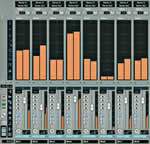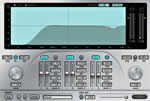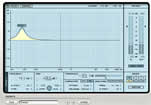See previous page:
Mixtering: A working model for an enhanced sound quality in electroacoustics
7. Annex: Comparative Mastering / Mixtering Session
7.1 Initial Analysis
The section from 07:10 to the end of the piece 08:52 was chosen for the analysis because of the important number of active stems here, which will allow for a more rich comparative analysis. The end of the piece is also a sort of summary of the sounds which appear throughout the work.

An overview of the extract we selected to work on will be helpful to follow the session (see Fig. 1).
Already the differences between these two versions in their initial state are noticeable (Audio 1 and 2):
In the “Source” version (Audio 1), we note that the the frequency distribution is better, the space is better defined and the overall sound is much more satisfying and open. The “Mix” version (Audio 2) is hard, resonant and artificially coloured.
It should be mentioned that the composer’s notes indicate that stems 2, 5 and 8 are identical in the two versions. Apparently all three come from a source that had already been equalized, so he didn’t feel it would be useful to process them in the mix. Out of curiosity, we audition these three stems by themselves (Audio 3):
Our suspicions are confirmed: these three stems had been excessively equalized and are resonant and aggressive.

Now let’s move on to the mastering of the “Mix” version.
7.2 “Mix” Version, Processing of the Stems
Stem 1 (Audio 4) is lacking body and is unnecessarily harsh in the higher frequencies. Figure 2 shows the proposed equalization, the result of which can be heard here (Audio 5):

The persistent crackling in stem 2 (Audio 6) is excessively exposed through an equalization that is aggressive in the mids and silences other elements in the stem, which consists of a sustained “melody” and a series of transients in the low-mids. Figure 3 shows the proposed equalization, Audio 7 the result:
Stem 3 (Audio 8) is an example of one of those situations in electroacoustics where it is impossible to win. The sound itself is aggressive and any attempt to soften it will bring about a notable loss of energy.


Stem 4 is an electric bass sound whose main problem is its timidity (Audio 10). The equalization is set to dynamic on the four bands, with two gains below the threshold, at 40 and 335 Hz, a cut above the threshold at 73 Hz and a gain above the threshold at 1.75 kHz (Fig. 5 and Audio 11).

Stem 5 (Audio 12) is again the product of the type of destructive equalization whose result is a combination of the masking of structuring elements and exposure of noisy and aggressive components. Static equalization will be applied to try to return some body and naturalness to the sound (Fig. 6 and Audio 13).
Stem 6 is thin and inefficient, but has nonetheless assumed an overly important place in the mix (Audio 14). The problem would be amplified if we re-established some of its body.


Stem 7 is both aggressive and static (Audio 16), as well as dominated by the mids and hi-mids. We will apply dynamic equalization to create some movement, bring out the low-mid and bass frequencies and restrain the hi-mids, all of which serve to give presence to the highs without even touching them (Fig. 8 and Audio 17).
Stem 8 (Audio 18) is somewhat vitreous, isn’t metallic enough and is again too thin. Here is the proposed equalization (Fig. 9 et Audio 19):

7.3 “Mix” version, Global Processing

The simple sum of the processsed stems 1–8 of the “Mix” version (Audio 20) is already less edgy and more open than the original (Audio 2), but the result is still far from satisfactory. The ensemble is still messy, the high frequencies dominate, the space is flat and overloaded. A more natural image with more depth is achieved by readjusting the levels of the more obtrusive stems, as can be seen in the screen capture in Figure 10, but this comes at the expense of the overall subjective level (Fig. 10 and Audio 21).
Resolution of the problem of “apparent volume” overall subjective level will require work at the master level. General equalization is applied (Figure 11) to cut more of the highs (-3 dB at 4.85 kHz; 2 octaves wide).

This equalization is followed by application of mild multiband compression / expansion and is completed by brickwall limiting. The result (Audio 22) can be compared with the original (Audio 2):
In comparison with the initial “Mix” version, the final result has a more comfortable overall sound, a better balance of the frequency profile and space, but the relation between the various components is quite different from that of the original. It should again be noted that the stems in this original had been systematically equalized to emphasize the hi-mid and upper frequencies, a situation which is impossible to correct properly without compromising some of the content. There is no secret here: if we wish to bring the lo-mids into a more reasonable balance with the overall mix, the stems in which the lo-mids have been eliminated will not offer any help. The following section describes processing applied to the “Source” stems — which have not been equalized — and and which, we hope, will provide us with a solution in which we will not only obtain the same — or better — level of listening comfort achieved above, but will at the same time preserve more of the composer’s original intention.
7.4 “Source” Version, Initial Comparison
It is not possible to directly compare the initial state of the “Source” stems group with the final mastered “Mix” version (Audio 22), as the overall subjective levels are too different. In order to obtain a more relevant point for comparison, the mastering treatments for the “Mix” version are also applied to the group of “Source” stems. Audio 23 is the result of this surprisingly instructive operation:
So we had to go through a complex and laborious process of problem-solving stem by stem, only to obtain a result that is almost as open as what could have been achieved if the composer had simply refrained from equalizing at all at the mixing stage? In that case, we could perhaps further explore the experience to see how far the “Source” version can be taken in terms of quality.

7.5 “Source” Version « Source », Processing of the Stems
First, let’s recall that stems 2, 5 and 8 were brought to the mixing stage with no processing. The exact same treatments as in the “Mix” version will be applied to them here; they therefore won’t be mentioned again in this section.
Stem 1 (Audio 24) is noisy, and has the same deficiencies as in its “Mix” version, albeit to a lesser degree. Application of noise reduction is followed by a “light” version of the equalization applied to the stem in the “Mix” version (Fig. 12 and Audio 25).

Stem 3 (Audio 26) only requires a slight reduction in the highs and some cleanup in the bass (Fig. 13 and Audio 27).

Of the four dynamic bands required for the electric bass (stem 4) in the “Mix” version (see Fig. 5),


In the “Mix” version, stem 6 was drowned in reverb, which helped the transition between the three principal sound masses of the section, but as we saw above, the reverb was so pervasive in the acoustic landscape that it had to be severely thinned (see Fig. 7).
After trying a few approaches, the best solution (Audio 30) seemed to be to do nothing to the stem: no reverb, no equalization.
Stem 7 is also fine as is. It is interesting to compare it with the end result of the treatments of this stem in the “Mix” version: it seems that once again, unintentionally, and similar to the global comparison in 7.4 above, the effect of the equalization is essentially a return to the original state of the stems, without equalization!
Now let’s compare the equalization of the “Mix” version (Audio 17) with the untreated “Source” version (Audio 32):

7.6 Final Result
The individual treatments are completed and we pass on to the stage of readjustments of the levels of the stems (Fig. 15).
The processing of the master is identical, with the exception of a general gain increase of 3 dB before the limiter, in order to obtain a reasonable subjective level. The result, the final mastering of the “Source” version (Audio 32), can be compared with the final mastering of the “Mix” version (Audio 22), and of course with the initial state of the extract, i.e. the “Mix” version before mastering:
The final mastered “Source” version (Audio 32) is not only more open, more comfortable, and has far superior impact than the mastered “Mix” version (Audio 22), but in comparison, it also seems far less coloured and much closer to the obvious intentions of the original. This is the only version which succeeds in helping the listener to appreciate the general ambiance and concentrate on the numerous details found in the excerpt, and brought to light by this session.
Social top